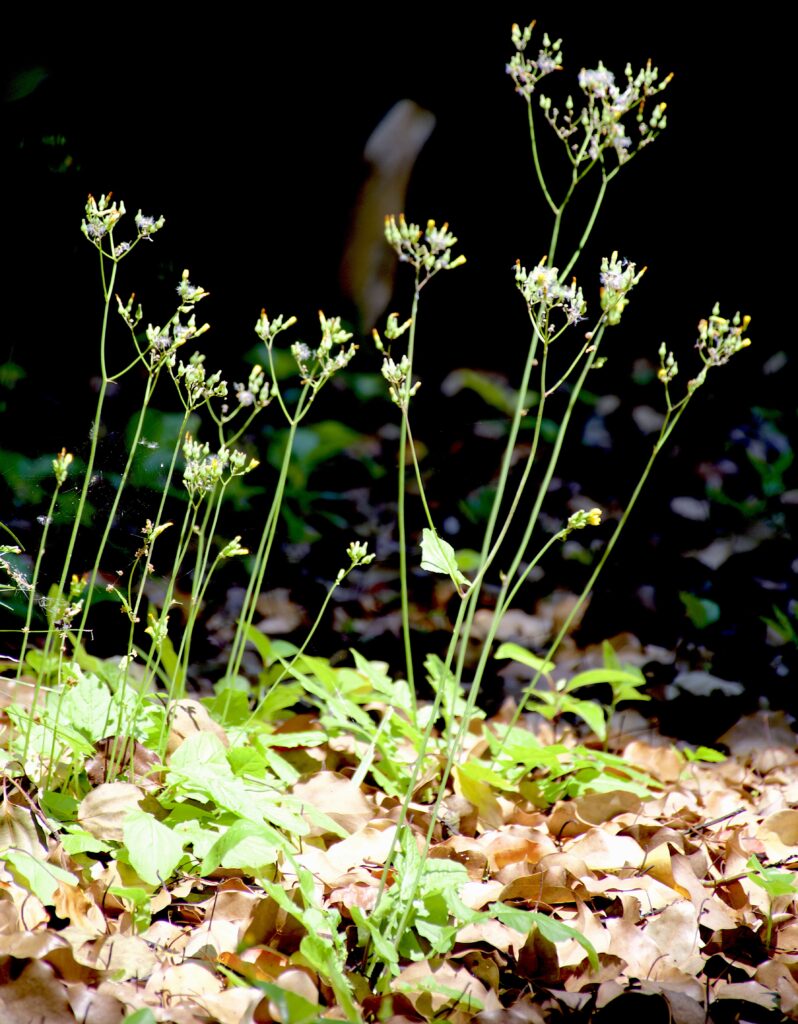
False Hawk’s beard Like cooler weather. Photo by Green Deane
Also making itself better know now is a Dandelion relative, the False Hawk’s Beard. While one can find it all year this edible favors the spring. It’s a very common lawn invader and can occasionally get up to a couple of feet tall. Young leaves are eaten raw, older leaves which can be tougher and a bit bitter, can be boiled. I have a Croatian friend who also cooks up the roots, too. They can be easily distinguished from the Dandelion by the flower stalk which is branched (unlike the Dandelion which has one straight stalk.) Also the False Hawk’s Beard can have blossoms in all stages of development at the same time, unopened, open, and going to seed. I have a video on it here . You can read more about the False Hawk’s Beard here.
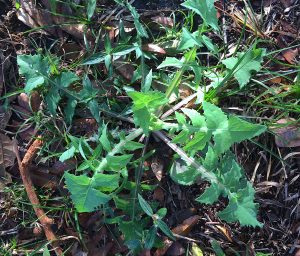
Sow Thistles make a nice winter pot herb and are related to Dandelions. Photo by Green Deane
Another not unexpected seasonal green this weekend was the sighting of Sow Thistles. Like its relative the Dandelion it, too, prefers the cooler months locally. Not a true thistle it’s one of the more milder seasonal greens. Although Sow Thistles are commonly called “thistles” they are not in the genus and do not draw blood like true thistles. True thistles are well-armed with needle-sharp spines. While the Sow Thistle can look intimidating it’s mostly just show in that the spines are soft. There are two species locally, the Common Sow Thistle and the Spiny Sow Thistle. The latter is a bit rougher than the former but no where near as abusive as true thistles. Both are slightly bitter raw. A few minutes of boiling or steaming takes away the bitterness completely (unlike wild lettuce which always stays slightly bitter.) I have a video on the sow thistles and to read more about them go here.
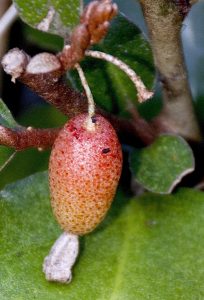
Silverthorn berries ripen in Feburary.
Another seasonal species to be looking for is Silverthorn one of the few fruits that sets in our winter and is usually ripe about Valentine’s Day. That’s handy because the jelly-bean sized fruit is red with a gold netting or spray on it. But, if you remember the red fruit is ready around Valentine’s Day you’ll be looking for it. The boxy blossoms help you identify which shrubs will be producing fruit this year. It’s a common landscape plant and also an escapee. We saw some blossom this past weekend in east Orlando. New fruit likes to grow on new growth and with waxy leave the species is fairly easy to identify. Even though the fruit is small it has the distinction of having the highest amount of the antioxidant lycopene per weight of any fruit. You can read about Silverthorn here and watch a video here.
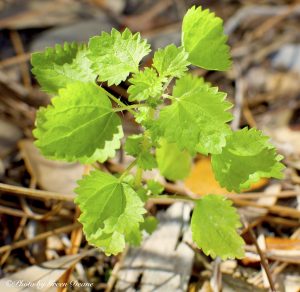
The mighty Heart Leaf Nettle. Photo by Green Deane
Our mighty stinging nettles are up. They’re one of the most popular wild edibles.The most powerful stinging nettle is in New Zealand (Urtica ferox) which kills animals and has claimed at least one human life. Our nettle, Urtica chamaedryoides, has a sting like a giant wasp and can burn for days or more. While its common name is a deceptive, “Heartleaf Nettle” its botanical gets to the point, “Stinging Dwarf.” Quite edible but you must handle it with care. If this particular species stings me it is not only extremely painful but a welt develops and the site is sensitive to temperature changes and any contact with any liquid for more than a week. The irritant compounds are histamines and acetocholines. Apparently I am quite sensitive to them though I can eat the plant raw or cooked (crushing the needles disarms them.) Also don’t confuse this plant with another stinging plant called the Spurge Nettle, Cnidoscolus stimulosus (video here ). That has an edible root but the leaves are usually not eaten. To learn more about the Heartleaf Nettle go here. For a video, here.
Lots of driving for me this weekend in a rental car. My two vehicles are in the garage. Saturday’s class is in Orlando and Sunday in Melbourne.

Foraging classes are held rain, shine, hot or cold. Photo by Nermina Krenata
Saturday January 7th Mead Garden: 1500 S. Denning Dr.Winter Park, FL 32789. Meet at the bathrooms. 9 a.m
Sunday January 8th, Wickham Park: 2500 Parkway Drive, Melbourne, FL 32935-2335. Meet at the “dog park” inside the park. 9 a.m.
Saturday January 14th, Eagle Park Lake, 1800 Keene Road, Largo, FL 33771. Meet at the pavilion near the dog park.
Sunday January 15th the Princess Place Preserve, 2500 Princess Place Rd, Palm Coast, FL 32137, 9 a.m. Meet at the parking lot.
For more information, to pre-pay or sign up go here.
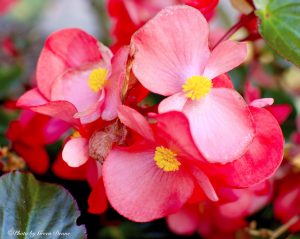 This might be a good time to mention that Begonias are edible. We saw some this weekend at my foraging class. Unfortunately a rather popular book some 30 years ago said they are not edible. I actually spoke with the author once and she told me in subsequent editions that mistake would be changed but the book never went into second edition. Thus the mistake can be found on the internet. Begonias are not only the favorite of growers (and cemetery pots) they are naturalized locally. I see them often in damp spots such as stream banks or drainage ditches. The leaves are edible as well as the blossoms. They can be prepared in a variety of ways and the juice is also a vegetarian rennet. My favorite are wax begonias (and the flavor can vary with their color.) You can read about them here.
This might be a good time to mention that Begonias are edible. We saw some this weekend at my foraging class. Unfortunately a rather popular book some 30 years ago said they are not edible. I actually spoke with the author once and she told me in subsequent editions that mistake would be changed but the book never went into second edition. Thus the mistake can be found on the internet. Begonias are not only the favorite of growers (and cemetery pots) they are naturalized locally. I see them often in damp spots such as stream banks or drainage ditches. The leaves are edible as well as the blossoms. They can be prepared in a variety of ways and the juice is also a vegetarian rennet. My favorite are wax begonias (and the flavor can vary with their color.) You can read about them here.
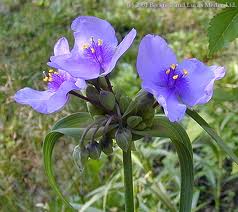 Spiderworts got me in trouble once. I let them cover my entire lawn in suburbia. That prompted a visit from Lawn Enforcement Officers. I was cited in writing for having an unkept lawn which meant covered with weeds (that they were pretty, native “weeds” was deemed irrelevant.) As I thought the citation wrong I read the pertinent law. It said a weed was a plant unintentionally over 18 inches high. Problem solved. My spiderworts were intentionally over 18-inches high. I watered and fertilized them. Consequently I beat the rap. And while Spiderworts favor the spring you can find them blossoming now here and there. Spiderworts are quite edible, at least all the parts above ground. They can be consumed raw, cooked or fermented. While this is not too descriptive they taste “green” to me, not distinctive but pleasant. Spiderworts have a history, by the way, being connected to John Smith of Pocahontas fame. You can read about them here.
Spiderworts got me in trouble once. I let them cover my entire lawn in suburbia. That prompted a visit from Lawn Enforcement Officers. I was cited in writing for having an unkept lawn which meant covered with weeds (that they were pretty, native “weeds” was deemed irrelevant.) As I thought the citation wrong I read the pertinent law. It said a weed was a plant unintentionally over 18 inches high. Problem solved. My spiderworts were intentionally over 18-inches high. I watered and fertilized them. Consequently I beat the rap. And while Spiderworts favor the spring you can find them blossoming now here and there. Spiderworts are quite edible, at least all the parts above ground. They can be consumed raw, cooked or fermented. While this is not too descriptive they taste “green” to me, not distinctive but pleasant. Spiderworts have a history, by the way, being connected to John Smith of Pocahontas fame. You can read about them here.
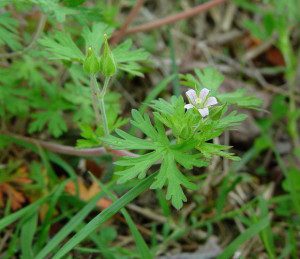
m’i’;l
Also found in lawns this time of year are wild geraniums, usually Cranesbill or Stork’s Bill. (Why one is one word and the other two-words possessive I do not know.) Botanically they are Geranium carolinianum and Erodium circutarium. Neither is great foraging. In fact both are more medicinal than edible but they seem to get mention in a variety of foraging books. The problem is they are extremely bitter. You might be able to toss a little bit of both in a salad but that’s about the extent of it. If you have what you think is a Cranesbill or a Stork’s Bill but it has more of a bottle brush blossom than five petals you might have the non-edible Fumaria. It comes up this time of year and from a distance the leaves can remind one of the wild geraniums. To read more about them go here.

You get the USB, not the key.
My nine-DVD set of 135 videos has been phased out and replaced by 171-videos on a 128-GB USB, see right. The USB videos are the same videos I have on You Tube. Some people like to have their own copy especially if social order falters. The USB videos have to be copied to your computer to play. If you want to order the USB go to the DVD/USB order button on the top right of this page or click here. That will take you to an order form. Or you can make a $99 donation, which tells me it is for the USB (include a snail-mail address.) I’d like to thank all of you who ordered the DVD set over the years which required me to burn over 5,000 DVDs individually. I had to stop making them as few programs now will read the ISO files to copy them. Burning a set also took about three hours.

Green Deane Forum
Want to identify a plant? Perhaps you’re looking for a foraging reference? You might have a UFO, an Unidentified Flowering Object, you want identified. On the Green Deane Forum we — including Green Deane and others from around the world — chat about foraging all year. And it’s not just about warm-weather plants or just North American flora. Many nations share common weeds so there’s a lot to talk about. There’s also more than weeds. The reference section has information for foraging around the world. There are also articles on food preservation, and forgotten skills from making bows to fermenting food. Recent topics include: Stale Bread and Cod Liver Oil, Killing Bugs with Tobacco Plugs, Eating weeds: Is it safe? Have they mutated? Not the Eastern Red Bug but the Pink Tabebuia, African Tulip Tree, Asparagus densiflorus, Green Deane’s Book… You can join the forum by clicking on the button on the upper right hand side of this page.
This is my weekly newsletter #538. If you want to subscribe to this free newsletter you can find the sign-up form in the menu at the top of the page. My website, EatTheWeeds.com, which is data secure, has over 1500 plants on it in some 428 articles. I wrote every one myself, no cut and paste.
To donate to the Green Deane Newsletter click here.News

